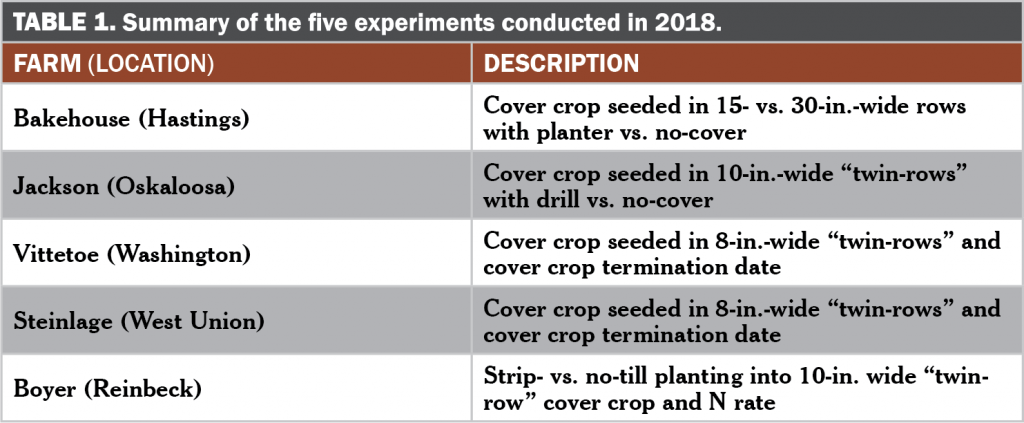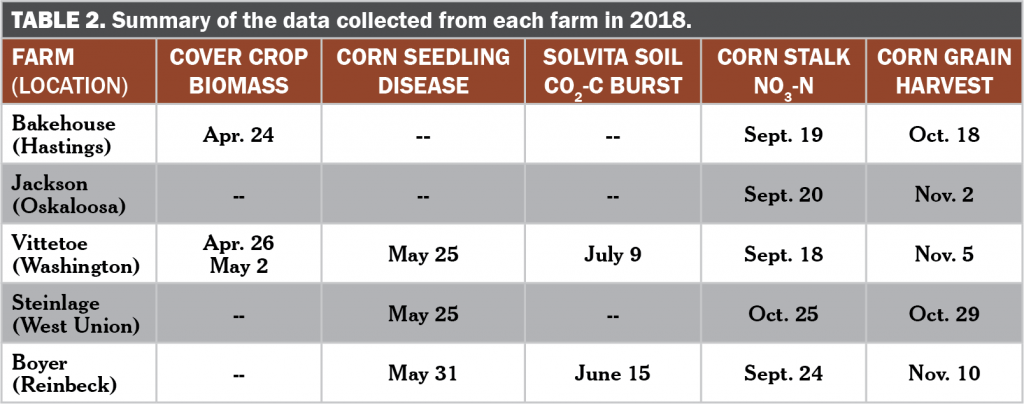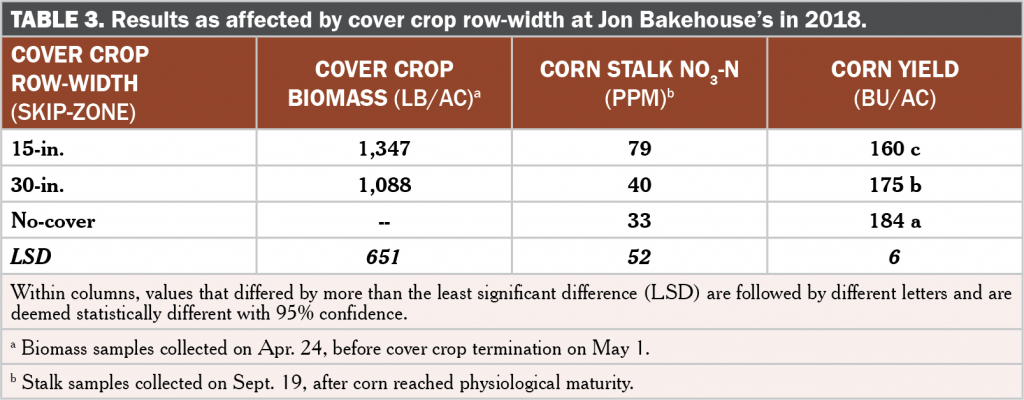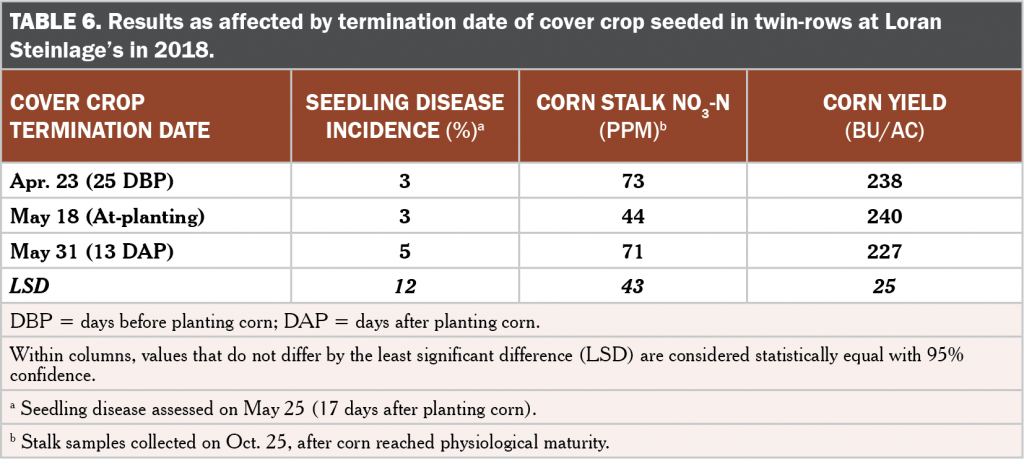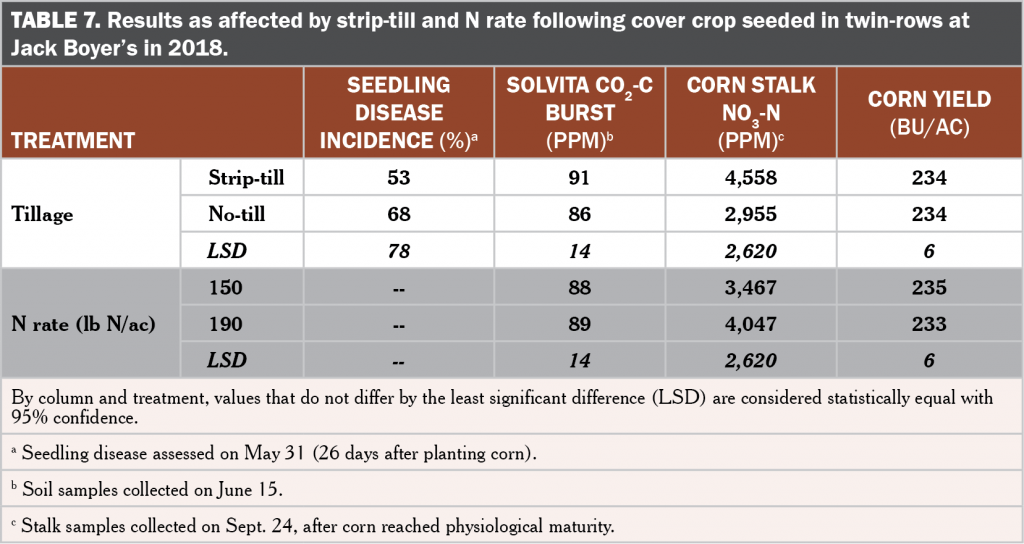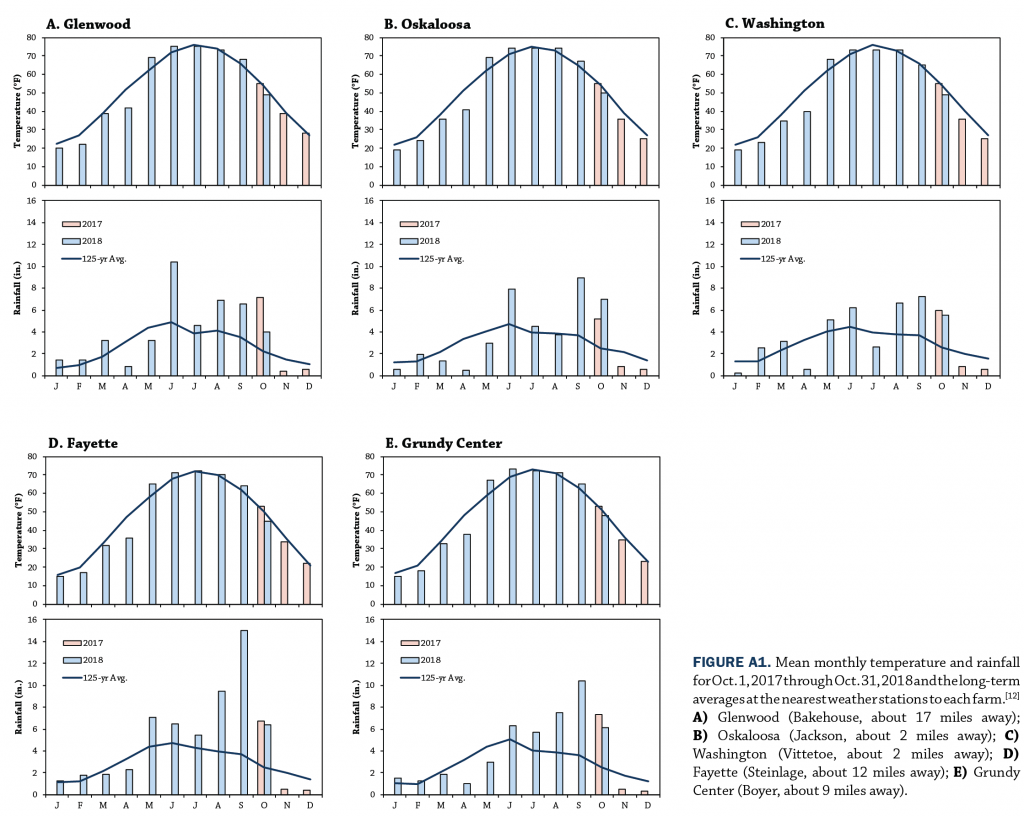In a Nutshell:
- Proper management is required for successfully overcoming yield drag in corn following a cereal rye cover crop. This typically involves waiting 10-14 days between cover crop termination and corn planting as well as applying a portion of N fertilizer near the time of planting.
- Farmer-cooperators Jon Bakehouse, Mike Jackson, Michael Vittetoe, Loran Steinlage and Jack Boyer investigated different seeding methods to achieve cover crop “skip zones” for corn that followed a cereal rye cover crop. The cooperators planted corn into these skip zones in order to determine if this could be part of a proper management plan for corn following a cover crop.
Key Findings
- Cover crop seeding methods had no effect on incidence of corn seedling disease across all locations.
- The cover crop reduced corn yields by 7–24 bu/ac at the Bakehouse and Jackson farms compared to where there was no cover crop.
- Delaying cover crop termination to after corn planting reduced yield by 8 bu/ac at Vittetoe’s but had no effect at Steinlage’s (235 bu/ac avg.).
- Boyer observed similar corn yields among tillage regimes and N fertilizer rates (234 bu/ac avg.).
Background
Research in Iowa has shown that corn yield drag from cereal rye cover crops can be avoided when proper management practices are used.[1] Proper management includes waiting to plant corn at least 10–21 days after chemically terminating a cover crop. In recent farmer-led research trials, PFI cooperators Dick Sloan and Tim Sieren attempted “planting green”: planting corn into a cover crop within two to three days of it being terminated. Corn yields in these cases were reduced by 5–21 bu/ac compared to where cover crops were terminated at least two weeks prior to planting the corn.[2,3] Recent research from Iowa State University has found increased disease pressure on corn seedlings and reduced corn yields when narrowing the time between cereal rye cover crop termination and corn planting[4] – giving further credence to waiting two weeks between terminating a cover crop and planting corn. Additionally, because cereal rye cover crops can result in early season soil and fertilizer N immobilization that can negatively affect crop yields,[5,6] proper management also includes a sufficient N fertilizer program. Studies by PFI cooperators[3,7] and researchers at Iowa State University[8] found that corn following a cereal rye cover crop does not require more N fertilizer than one’s typical N program (i.e., corn following no cover crop). As such, many farmers are finding success when planting corn at least 10 days after terminating the cover crop, applying 30–70 lb N/ac near the time of corn planting and applying the balance of their N program at side-dress. In the present project, cooperators sought to investigate more practices that could fall under the category of proper management when it comes to planting corn following a cover crop.
Objective: Determine if creating skip zones while seeding cover crops and then planting corn into these skip zones could be part of a proper management plan for corn following a cereal rye cover crop. Farmer-cooperators created skip zones by using planters to seed cover crops in wide rows or by plugging seed drill openers while seeding cover crops and ending up with cover crops in twin rows.
Conceivably, the skip zones could alleviate negative effects on corn growth and development that has been previously documented by a cereal rye cover crop. “I want a better understanding of the impact [on corn yield] of a cereal rye cover crop’s proximity to the corn row,” Jack Boyer said about his reason for participating in this study. Michael Vittetoe’s goal for participating was to “learn what adjustments to our management practices are needed in order to successfully plant corn into a green cereal rye cover crop.” Jon Bakehouse, another participant, considered skip zones as a means to provide him more confidence to seed a cereal rye cover crop before corn.

LEFT: Strips of cereal rye cover crop seeded in 30- and 15-in. row-widths at Jon Bakehouse’s on Mar. 29, 2018. RIGHT: Cereal rye cover crop seeded in 30- and 15-in. row-widths at Jon Bakehouse’s on Apr. 23, 2018.
Methods
This study consisted of several similar on-farm experiments conducted by Jon Bakehouse near Hastings in Mills County; Mike Jackson near Oskaloosa in Mahaska County; Michael Vittetoe near Washington in Washington County; Loran Steinlage near West Union in Fayette County; and Jack Boyer near Reinbeck in Tama County. These experiments are summarized in Table 1 with more details below. The previous crop was soybean at all locations.
Bakehouse – Planter-seeded cover crop in wide rows
Bakehouse achieved skip zones by seeding a cereal rye cover crop in the fall in 15- and 30-in. rows with a planter that he typically uses for seeding corn and soybean crops. This resulted in corn planted into either a 15-in.-wide skip zone (two rows of cover crop between each corn row) or a 30-in.-wide skip zone (one row of the cover crop between each corn row). He also included a no-cover control treatment where no cereal rye was seeded. The three treatments (15-in. skip, 30-in. skip and no-cover) were arranged in a randomized complete block design with four replications. Strips measured 30 ft wide and 680 ft long (0.5 ac each).
Bakehouse seeded the cereal rye cover crop at 40 lb/ac in the 15-in. row-width treatment and at 20 lb/ac in the 30-in. row-width treatment on Sept. 24, 2017. The cover crop was seeded with a Kinze 3600 12/23 InterPlant planter using brush type meters with backing plates. Cereal rye was terminated on May 1, 2018 with Durango (24 oz/ac). Corn was planted in 30-in. rows on May 1 at a population of 32,000 seeds/ac. In the 15-in. skip and 30-in. skip treatment strips, the corn was planted into the skip zones (e.g., between the former cereal rye rows). Nitrogen fertilizer was applied pre-plant on Apr. 24 at a rate of 70 lb N/ac as UAN(32). Additional N fertilizer was side-dressed to all strips at a rate of 70 lb N/ac as UAN(32) on June 6. Weed control consisted of Durango (24 oz/ac) and Capreno (3 oz/ac) applied on May 24. Corn was harvested on Oct. 18.
Jackson – Skip zones vs. no-cover
Jackson created skip zones by plugging every third row-opener on his drill such that he seeded a cover crop in 10-in.-wide “twin rows” on 30-in. centers. This resulted in corn planted into 20-in.-wide skip zones with two cover crop rows between the eventual corn row. He also included a no-cover control treatment where no cover crop was seeded. The two treatments (20-in. skip and no-cover) were arranged in a randomized complete block design with four replications. Strips measured 20 ft wide and 1,027 ft long (0.5 ac each).
Jackson seeded the cereal rye cover crop at on Nov. 6, 2017. The cereal rye was terminated the following spring with glyphosate. Corn was planted in 30-in. rows on Apr. 25. In the 30-in. skip treatment strips, the corn was planted into the skip zones (e.g., two former cereal rye rows in each corn interrow). Nitrogen fertilizer and weed control information was not provided. Corn was harvested on Nov. 2.

LEFT: Cereal rye cover crop seeded in 10-in. twin rows at Mike Jackson’s on Apr. 18, 2018. RIGHT: At left, cereal rye cover crop was terminated four days before planting corn. At right, cereal rye cover crop was terminated eight days after planting corn. Photo taken May 30, 2018 at Michael Vittetoe’s.
Vittetoe – Skip zones and termination date
Vittetoe created skip zones by modifying the row unit configuration on his drill such that he seeded a cover crop in 8-in.-wide “twin rows” on 30-in. centers. This resulted in corn planted into a 22-in.-wide skip zone with two cover crop rows between the eventual corn rows. Treatments comprised of terminating the cover crop near the time of corn planting and one week after corn planting. The two termination date treatments were arranged in a randomized complete block design with four replications. Strips measured 120 ft wide and 4,810 ft long (13.3 ac each).
Vittetoe seeded a cereal rye + oats cover crop at approximately 20 lb/ac each on Oct. 3, 2017. The cover crop was terminated on Apr. 26 (4 days before planting corn) or May 8 (8 days after planting corn), 2018 with glyphosate (40 oz/ac). Corn was planted in 30-in. rows on Apr. 30 at a population of 35,000 seeds/ac. Nitrogen fertilizer was applied as hog manure (4,000 gal/ac with a N analysis of 40 lb N/1,000 gal = 160 lb N/ac) in Fall 2017; at planting at 60 lb N/ac as UAN(32); and as side-dress at 40 lb N/ac as UAN(32) in late May. The total amount of N applied as manure and fertilizer was 260 lb N/ac. Weed control consisted of Acuron (3 qt/ac) applied on May 22. Corn was harvested on Sept. 22.
Steinlage – Skip zones and termination date
Steinlage created skip zones by seeding a cover crop in 8-in.-wide “twin rows” on 30-in. centers. This resulted in corn planted into a 22-in.-wide skip zone with two cover crop rows between the eventual corn rows. Treatments comprised of terminating the cover crop three weeks before planting corn, at the time of corn planting, and two weeks after corn planting. The three termination date treatments were arranged in a randomized complete block design with four replications. Strips ran the length of the field.
Steinlage seeded a cereal rye cover crop in Fall 2017. The cover crop was terminated on Apr. 23 (25 days before planting corn), May 18 (at-planting corn) or May 31 (13 days after planting corn), 2018 with glyphosate. Corn was planted in 30-in. rows on May 18. Nitrogen fertilizer and weed control information was not provided. Corn was harvested on Oct. 29.
Boyer – Strip-till vs. no-till and N-rate in drill-seeded skip zones
Boyer created skip zones by using a modified Hiniker drill that seeded the cover crop in 10-in.-wide “twin rows” on 30-in. centers. This resulted in corn planted into a 20-in.-wide skip zone with two rows of cover crop between the eventual corn rows. The experimental design was a randomized complete block with a split-plot treatment arrangement. Main plot treatments were strip-till vs. no-till. Main plots were divided into two, side-by-side split-plots. The split-plot treatments were two N fertilizer rates: low vs. high (difference achieved at side-dress). Each main × split-plot treatment was replicated four times. The main plot treatment strips (strip-till skip and no-till skip) measured 30 ft wide and ran the length of the field.
Boyer seeded the cereal rye cover crop on Nov. 7, 2017 at 61 lb/ac. The skip zones were tilled on Apr. 26, 2018 in the strip-tillage main plot treatment strips. Cereal rye cover crop in all strips was terminated on May 5 with an application of Gramoxone (2 qt/ac), Outlook (10 oz/ac), and Atrazine 4L (32 oz/ac) along with 30 lb N/ac as UAN. Corn was planted to all strips in 30-in. rows on Apr. 29 at a population of 34,000 seeds/ac. Nitrogen fertilizer was applied at 120 lb N/ac as anhydrous ammonia to the entire field on Apr. 23. A side-dress application of 40 lb N/ac as anhydrous ammonia was made to half of the split-plot strips on June 1 to achieve the high N rate. Total N rates for the low and high split-plot treatments were 150 and 190 lb N/ac, respectively. Weed control consisted of Impact (1 oz/ac), atrazine (16 oz/ac), Roundup Powermax (32 oz/ac) and Zaar (16 oz/ac) applied on May 31. Headline (10 oz/ac) fungicide was applied to all strips on July 22. Corn was harvested on Nov. 10.
Field sampling
Sampling varied among locations; samples collected and dates of sampling for each of the locations are summarized in Table 2.
Cover crop aboveground biomass samples were collected shortly before or after herbicide termination at the Bakehouse and Vittetoe locations by Theo Gunther at the Iowa Soybean Association. All other locations had low amounts of cover crop growth which precluded sampling.
Soil samples were collected to a depth of 6-in. in June or July. Sample collection at the Vittetoe farm was conducted by Continuum Ag (Washington, IA). Samples were sent to AgSource Laboratories (Ellsworth, IA) to determine the burst of CO2-C following rewetting of dried soil using the Solvita assay – a measurement of soil microbial activity.
Incidence of corn seedling disease (root rot) was assessed in late May by Dr. Alison Robertson’s lab team from the ISU Department of Plant Pathology and Microbiology.
Corn stalk samples were collected for NO3-N concentration analysis after the corn reached physiological maturity by Theo Gunther at Iowa Soybean Association.
Corn was harvested individually from each strip on all farms and corrected to 15.5% moisture.
Data were analyzed using JMP Pro 13 (SAS Institute Inc., Cary, NC) statistical software. Means separations are reported using Tukey’s Least Significant Difference (LSD). Statistical significance was determined at the 95% confidence level.
Results and Discussion
Bakehouse
Cover crop row-width did not affect the amount of cover crop biomass observed near the time of cover crop termination in late April at the Bakehouse farm (Table 3). Across row-width treatments, the average amount of cover crop biomass was 1,218 lb/ac. Corn stalk nitrate concentration fell into the “low” category (<250 ppm) according to ISU Extension and Outreach[9] and did not differ among treatments.
Corn yield decreased as the cover crop row-width decreased (Table 3). Greatest yields were achieved with no-cover (184 bu/ac) and lowest yields occurred where the cover crop was seeded in 15-in. row-widths (160 bu/ac). Planting the cover crop in 30-in. row-widths improved corn yields by 15 bu/ac compared to planting the cover crop in 15-in. row-widths. Cover crops, however, resulted in corn yields below the five-year average for Mills County of 184 bu/ac.[10] Bakehouse terminated the cover crops on the say date he planted corn (May 1). Previous research by PFI cooperators has shown yield decreases ranging from 5–28 bu/ac when corn was planted near the time of cover crop termination compared to when the cover crop was terminated three weeks before corn planting.[2,3] Terminating the cover crops at Bakehouse’s two to three weeks before corn planting may have improved corn yields.
Jackson
The presence or absence of the cover crop seeded in 10-in.-wide twin rows (20-in.-wide skip zone) at the Jackson farm did not affect corn stalk nitrate concentration (Table 4). Both treatments resulted in concentrations falling into the “sufficient” category (250–2,000 ppm) according to ISU Extension and Outreach.[9]
Corn yield, however, was decreased by 7 bu/ac by the cover crop (Table 4). Regardless of this yield difference, corn yields from both treatments were well above the five-year average for Mahaska County of 186 bu/ac.[10]
Vittetoe
Terminating the cover crop seeded in twin rows eight days after planting corn (Apr. 30) resulted in nearly twice as much biomass produced as terminating four days before planting corn at the Vittetoe farm (Table 5). Over 900 lb of additional biomass was produced by the cover crop that was allowed 12 more days of growth.
 Cover crop termination date did not affect the amount of corn seedling disease observed, the CO2-C soil burst or corn stalk nitrate concentration. While corn stalk nitrate concentrations did differ numerically, they did not, however, differ statistically between the two treatments (Table 5). Averaged across both treatments, corn stalk nitrate concentrations fell into the “sufficient” category (250–2,000 ppm) according to ISU Extension and Outreach.[9]
Cover crop termination date did not affect the amount of corn seedling disease observed, the CO2-C soil burst or corn stalk nitrate concentration. While corn stalk nitrate concentrations did differ numerically, they did not, however, differ statistically between the two treatments (Table 5). Averaged across both treatments, corn stalk nitrate concentrations fell into the “sufficient” category (250–2,000 ppm) according to ISU Extension and Outreach.[9]
Corn yield decreased by 8 bu/ac when cover crop termination was delayed to eight days after planting corn (Table 5). This yield reduction could have been due to early season competition from the cover crop, the increased amount of cover crop biomass produced, shading of corn seedlings, or a combination of all three, in this treatment. Recent research in Iowa demonstrated that corn populations and yields decreased as cover crop biomass increased.[11] Yields from both treatments at Vittetoe’s in 2018, however, were well above the five-year average for Washington County of 195 bu/ac.[10]
Steinlage
Termination date of cover crops seeded in twin rows did not affect the amount of corn seedling disease observed or corn stalk nitrate concentration at the Steinlage farm (Table 6). Across all three treatments, concentrations fell into the “low” category (<250 ppm) according to ISU Extension and Outreach.[9]
Cover crop termination date did not affect corn yield and yields were well above the five-year average for Fayette County of 191 bu/ac.[10]
Boyer
Though, cover crop biomass was not sampled, Boyer estimated that the cereal rye was approximately 4 in. tall when it was terminated. Strip-tillage of the skip zone between the twin row cover crops at the Boyer farm did not affect the amount of corn seedling disease observed, the CO2-C soil burst or corn stalk nitrate concentration (Table 7). Nitrogen fertilizer rate also had no effect on the CO2-C soil burst or corn stalk nitrate concentration. Regardless of treatment, corn stalk nitrate concentrations fell into the “high” category (>2,000 ppm) according to ISU Extension and Outreach.[9] The corn at Boyer’s was not lacking for N.
Neither tillage nor N fertilizer rate had any effect on corn yields (Table 7) and yields were well above the five-year average for Tama County of 192 bu/ac.[10] These results align with previous findings by PFI cooperators[3,7] and ISU researchers[8] that found corn did not require “extra” N fertilizer when following a cereal rye cover crop. In Boyer’s case in 2018, the strip-tillage pass and the 40 lb of additional N fertilizer can be considered unnecessary, extra costs.
Conclusions and Next Steps
These trials assessed strategies for eliminating any cereal rye cover crop influence from the eventual corn row zone. The farmers involved in this study hypothesized that creating planting zones for corn that were free of cover crop might help to reduce the potential for corn yield drag. These cover crop “skip zones” were created with different cover crop seeding methods that ranged from planting in 30-in. row-widths to drilling in twin rows.
None of the cover crop seeding methods had an effect on corn seedling disease incidence (root rot) or the Solvita soil CO2-C burst (soil microbial activity). The relatively low amounts of cover crop biomass observed at the farms (<2,000 lb/ac) may have been the reason why none of the treatments had any effect on seedling disease incidence. Researchers at ISU documented disease (root rot) in over 90% of seedlings sampled when the cereal rye cover crop produced upwards of 3,500 lb/ac of biomass and was terminated three days before or one day after planting corn.[4]
Corn yield response to the seeding strategies, however, varied across locations. Bakehouse and Jackson were the only locations to include control strips with no cover crops. At both locations, corn yields were reduced by cover crops despite the skip zones both farmers created (Tables 3 and 4). Vittetoe and Steinlage compared termination dates of their twin row cover crops relative to their corn planting dates. At Vittetoe’s, delaying termination to 8 days after planting corn reduced yields compared to when he terminated the cover crop 4 days before planting corn (Table 5). Termination date at Steinlage’s varied from 25 days before planting corn to 13 days after planting corn; he saw no difference in corn yield (Table 6). Boyer evaluated tillage within the skip zones and N fertilizer rates. He saw no yield difference among treatments (Table 7). Refraining from tilling the skip zones (strip-till) and applying 150 lb N/ac (compared to 190 lb N/ac) reduced overall costs of production. “I was able to confirm that equal yields could be obtained with no-till and strip-till,” Boyer said of the results. “I plan to reduce my N fertilizer rates and increase my use of no-till [as a result of this study].”
Practical Farmers of Iowa cooperators plan to continue to partner with plant pathologists at Iowa State University to further explore any effects of cereal rye cover crops on corn. The goal of both the farmers and researchers involved is to continue to evaluate and establish best management practices and encourage increased use of cover crops on the Iowa agricultural landscape.
Appendix – Weather Conditions
References
- Gailans, S. and L. Juchems. 2018. Winter Cereal Rye Cover Crop Effect on Cash Crop Yield: Year 10. Practical Farmers of Iowa Cooperators’ Program and Iowa Learning Farms. https://practicalfarmers.org/wp-content/uploads/2019/01/18.FC_.CC.Winter_Rye_Effect_on_Yield_Year_10.pdf (accessed March 2019).
- Gailans, S. and D. Sloan. 2016. Cover Crop Termination Date Ahead of Corn. Practical Farmers of Iowa Cooperators’ Program. https://practicalfarmers.org/wp-content/uploads/2018/10/16.FC_.CC.Cover_Crop_Termination_Date_Corn.pdf (accessed March 2019).
- Gailans, S., D. Sloan and T. Sieren. 2017. N Fertilizer Strategies for Corn Following Cover Crop. Practical Farmers of Iowa Cooperators’ Program. https://practicalfarmers.org/wp-content/uploads/2018/10/17.FC_.CC.N-fert-strategies-for-corn-after-cover.compressed.pdf (accessed March 2019).
- Acharya, J., M.G. Bakker, T.B. Moorman, T.C. Kaspar, A.W. Lenssen and A.E. Robertson. 2016. Time Interval Between Cover Crop Termination and Planting Influences Corn Seedling Disease, Plant Growth, and Yield. Plant Disease. 101:591–600. https://apsjournals.apsnet.org/doi/pdfplus/10.1094/PDIS-07-16-0975-RE (accessed March 2019).
- Vaughan, J.D. and G.K. Evanylo. 1998. Corn response to cover crop species, spring desiccation time, and residue management. Agronomy Journal. 90:536–544. https://www.researchgate.net/profile/Gregory_Evanylo/publication/237976342_Corn_Response_to_Cover_Crop_Species_Spring_Desiccation_Time_and_Residue_Management/links/548b57550cf225bf669f884d/Corn-Response-to-Cover-Crop-Species-Spring-Desiccation-Time-and-Re (accessed March 2019).\
- Hill, E.C., K.A. Renner and C.L. Sprague. 2016. Cover crop impact on nitrogen availability and dry bean in an organic system. Agronomy Journal. 108:329–341. https://dl.sciencesocieties.org/publications/aj/pdfs/108/1/329 (accessed March 2019).
- Gailans, S., T. Smith, R. Stout and J. Gustafson. 2014. Side-dressing Corn following a Winter Rye Cover Crop — Updated 2014. Practical Farmers of Iowa Cooperators’ Program. https://practicalfarmers.org/wp-content/uploads/2018/12/14.FC_.CC.side-dress-N_UPDATE.pdf (accessed March 2019).
- Pantoja, J.L., K.P. Woli, J.E. Sawyer and D.W. Barker. 2015. Corn Nitrogen Fertilization Requirement and Corn–Soybean Productivity with a Rye Cover Crop. Soil Science Society of America Journal. 79:1482. https://dl.sciencesocieties.org/publications/sssaj/pdfs/79/5/1482 (accessed March 2019).
- Sawyer, J. and A.P. Mallarino. 2018. Cornstalk Testing to Evaluate Nitrogen Management. PM 1584. Iowa State University Extension and Outreach. https://store.extension.iastate.edu/product/Use-of-the-End-of-Season-Corn-Stalk-Nitrate-Test-in-Iowa-Corn-Production (accessed March 2019).
- US Department of Agriculture-National Agricultural Statistics Service. Quick stats. USDA-National Agricultural Statistics Service. https://quickstats.nass.usda.gov/ (accessed March 2019).
- Kaspar, T.C. and M.G. Bakker. 2015. Biomass production of 12 winter cereal cover crop cultivars and their effect on subsequent no-till corn yield. Journal of Soil and Water Conservation. 70:353–364. http://www.jswconline.org/content/70/6/353.short (accessed March 2019).
- Iowa Environmental Mesonet. 2019. Climodat Reports. Iowa State University. http://mesonet.agron.iastate.edu/climodat/ (accessed March 2019).


